A pair of planetary explorers at Mercury
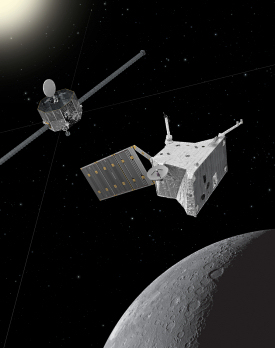 |
| BepiColombo at Mercury. Credit: ESA/ATG medialab |
The BepiColombo mission differs in one immediately evident way from its Mercury-exploring forebears: it consists of not one but two spacecraft orbiting the planet at the same time.
BepiColombo comprises ESA's Mercury Planetary Orbiter (MPO) and JAXA's Mercury Magnetospheric Orbiter (also referred to as Mio), both of which will work together to better understand the Solar System's innermost planet.
MPO and Mio journey to Mercury together with the Mercury Transfer Module (MTM). When approaching Mercury, the MTM will separate and the two spacecraft, still together, will be captured into a polar orbit around the planet. Their altitude will be adjusted using MPO's thrusters until Mio's orbit of 590 km by 11 640 km above the surface has been reached – here Mio will complete a single orbit in 9.3 hours. MPO will then separate and descend to its own 480 km by 1500 km orbit above the surface – here MPO will complete one orbit in 2.3 hours. Both orbits will be polar.
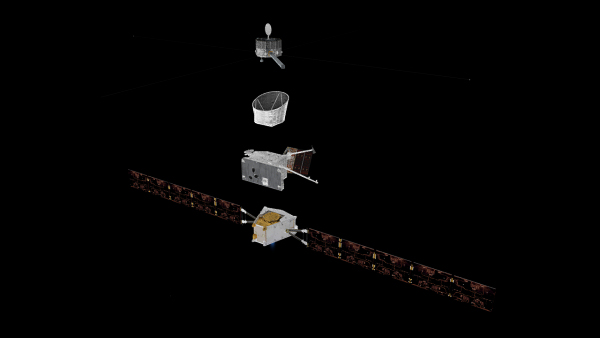 |
| BepiColombo exploded view. Credit: ESA/ATG medialab |
Each spacecraft carries a unique suite of advanced scientific instruments and sensors to observe and explore different elements of Mercury. However, they will also combine and compare their data and work together, allowing them to achieve far more than a single spacecraft could.
The spacecraft and their instruments
The Mercury Planetary Orbiter (MPO) carries a suite of 11 scientific instruments:
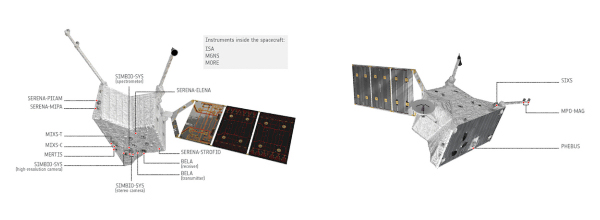 |
| BepiColombo MPO's science instruments. Credit: ESA/ATG medialab |
- BepiColombo Laser Altimeter (BELA)
to study Mercury's surface morphology, topography, and map the surface to create a model of the terrain
(Principal Investigators: Nicolas Thomas, University of Bern, Switzerland, and Hauke Hussmann, DLR Institut für Planetenforschung, Berlin, Germany) - Italian Spring Accelerometer (ISA)
used in conjunction with other datasets to characterise Mercury's interior structure, and test Einstein's General Theory of Relativity.
(Principal Investigator: Valerio Iafolla, INAF-IAPS Istituto di Astrofisica e Planetologia Spaziali, Rome, Italy) - Magnetic Field Investigation (MPO-MAG)
to probe Mercury's magnetic field and environment (its magnetosphere, and how this interacts with the solar wind) and explore how it is generated and sustained, and by extension better understand the planet's interior structure and evolution.
(Principal Investigator: Daniel Heyner, Technische Universität Braunschweig, Germany) - Mercury Radiometer and Thermal Imaging Spectrometer (MERTIS)
to study Mercury's surface composition and mineralogy (important for modelling the planet's formation)
(Principal Investigator: Harald Hiesinger, University of Münster, Germany) - Mercury Gamma-ray and Neutron Spectrometer (MGNS)
to gather data on Mercury's surface and subsurface composition, and hunt for volatile deposits across the planet and in its shadowed polar craters (where water ice may exist).
(Principal Investigator: Igor Mitrofanov, Russian Academy of Sciences, Space Research Institute, IKI, Moscow, Russian Federation) - Mercury Imaging X-ray Spectrometer (MIXS)
to map Mercury's surface atomic composition at high spatial resolution.
(Principal Investigator: Emma Bunce, Space Research Centre, University of Leicester, UK) - Mercury Orbiter Radio science Experiment (MORE)
to characterise Mercury's size, internal structure and the physical state of its core, and test elements of gravity theory.
(Principal Investigator: Luciano Iess, University of Rome 'La Sapienza', Italy) - Probing of Hermean Exosphere by Ultraviolet Spectroscopy (PHEBUS)
to understand the composition, dynamics, and characteristics of Mercury's exosphere, and hunt for possible water ice in craters at Mercury's poles.
(Principal Investigator: Eric Quémerais, LATMOS-IPSL, Guyancourt, France) - Search for Exosphere Refilling and Emitted Neutral Abundance (SERENA)
to study how gas interacts within and between various regions of Mercury and its cosmic environment (its surface, exosphere, magnetosphere, the solar wind).
(Principal Investigator: Stefano Orsini, INAF-IAPS Istituto di Astrofisica e Planetologia Spaziali, Rome, Italy) - Spectrometers and Imagers for MPO BepiColombo Integrated Observatory System (SYMBIO-SYS)
to image and spectrally probe the geology, age, geophysics, and composition of Mercury's surface, and explore possible volcanism and tectonics.
(Principal Investigator: Gabriele Cremonese, INAF-Osservatorio Astronomico di Padova, Italy) - Solar Intensity X-ray Spectrometer (SIXS)
to continuously study Mercury's environment and observe particles arriving from the Sun (X-rays).
(Principal Investigator: Juhani Huovelin, University of Helsinki, Department of Physics, Finland)
The Mercury Magnetospheric Orbiter (Mio) will carry five advanced instruments:
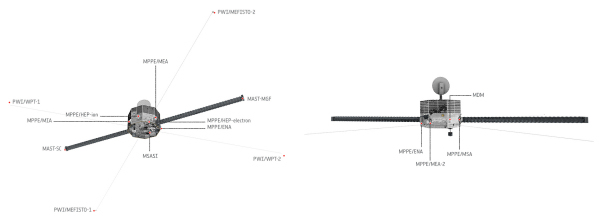 |
| BepiColombo Mio's science instruments. Credit: ESA/ATG medialab |
- Mercury Magnetometer (MMO-MAG)
to characterise Mercury's magnetic environment and the interactions within it (magnetic field, magnetosphere, solar wind).
(Principal Investigator: Wolfgang Baumjohann, Austrian Space Science, Graz, Austria) - Mercury Plasma Particle Experiment (MPPE)
to explore the material within Mercury's magnetosphere (high- and low-energy particles).
(Principal Investigator: Yoshifumi Saito, Institute of Space and Astronautical Science, Kanagawa, Japan) - Mercury Plasma Wave Instrument (PWI)
to analyse the magnetosphere's structure and dynamics.
(Principal Investigator: Yasumasa Kasaba, Tohoku University, Sendai, Japan) - Mercury Sodium Atmospheric Spectral Imager (MSASI)
to study the sodium content of Mercury's atmosphere (exosphere).
(Principal Investigator: Ichiro Yoshikawa, University of Tokyo, Japan) - Mercury Dust Monitor (MDM)
to observe the amount and distribution of dust within Mercury's orbit.
(Principal Investigator: Masanori Kobayashi, Chiba Institute of Technology, Japan)
Crucially, both spacecraft carry a magnetometer. These instruments are designed to probe every aspect of Mercury's magnetism: the structure, properties, and dynamics of the planet's internally-generated magnetic field and wider magnetic environment (the magnetosphere, the region of space influenced by Mercury's magnetic field), and how both of these interact with the continuous stream of charged particles flooding out towards Mercury from the Sun (the solar wind).
Characterising Mercury's magnetism
One of the most surprising discoveries from Mariner 10 was that Mercury has an Earth-like magnetic dipole field. The terrestrial magnetic field is generated by the churning motions of molten metal in the Earth's core, sometimes described as a 'planetary dynamo'. Given Mercury's small size and slow rotation, scientists believe that its core cooled long ago and that it is now composed of solid iron—and thus unable to generate any dynamo-like movement.
However, Mariner 10's detection of a magnetic field at Mercury was confirmed by MESSENGER, which characterised this field, finding it too to be a dipole, generally stable but uneven in strength—significantly stronger in its northern than southern hemisphere, and facilitating the escape of material in some areas, in other words, "leaking" into space.
Compared to Earth's, Mercury's magnetic field is weak (100-150 times weaker). While some phenomena known to take place in the Earth's magnetosphere have also been observed in Mercury's, the two seem to be very different in terms of strength and dynamics.
These differences are one of the key focuses of the MPO and MMO. How do the two magnetospheres and fields differ? Why is Mercury's field so much weaker than Earth's—does location in space play a role? What dynamics and phenomena take place in the Hermean field? How is Mercury's magnetic field structured, and how does it behave over time? When did it form, and how is it generated today?
Some of these questions will require multiple sets of independent observations to answer. MMO and MPO will orbit in different areas of Mercury's magnetosphere at different times and on different timescales (periods), allowing them to simultaneously measure different spatial and temporal characteristics of the same global system.
By combining the data, the two magnetometers can be used to describe the structure, dynamics, and strength of Mercury's magnetosphere across space and time.
This approach is crucial for distinguishing between the various sources of magnetism (internal dynamo, remnant surface magnetism from ancient sources, interaction with the solar wind, and others), understanding it on a planet-wide scale (rather than in small localised areas occupied by a single spacecraft), and characterising the intense and harsh environment existing near the Sun.
Cosmic cooperation
The same concept is true for much of the MPO and Mio payload.
For example, the MPO/SERENA package of particle-probing instruments will be able to work closely with Mio's plasma experiments (MPPE) to better understand the gas and plasma existing in and around Mercury's orbit.
Instruments aimed at exploring Mercury's internal structure and magnetism will benefit from comparing and combining their data with other experiments. Such collaboration will allow them to distinguish, for example, which parts of Mercury's magnetic field are static or internally-generated, and which are variable and produced externally by interaction with the solar wind.
BepiColombo's two probes will have a large advantage over solo spacecraft, working together to explore the planet and its environment on a global scale—something that has never before been done at Mercury.
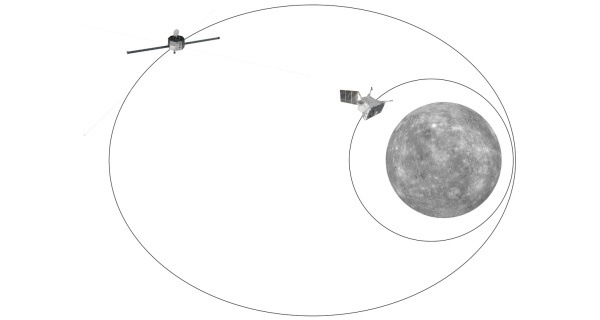 |
| BepiColombo orbits. Credit: ESA/ATG medialab |
